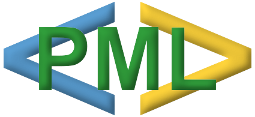PERSONNALISABLE MARKUP LANGUAGE
PRESENTATION
Version 0.10.1, february 17
Why PML?
PML was born from the idea that we could make HTML documents easier, more readable and more powerful.
☑ Easier, because replacing the system of opening and closing tags with bounding tags, we reduce the congestion of them.
☑ More readable, because thanks to the reduction of the clutter of tags and a system of metatags, we are getting closer to the native text.
☑ More powerful, because you can, thanks to metatags, use shorter commands that do more.
Any HTML file is directly convertible into PML and vice versa.
Principle
The basic principle of PML is to replace the group
<tag>text</tag>
by
<tag text>
the text can itself contain tags.
Example:
To display “Chapter 1st”, you must code in HTML:
<h1>Chapter 1<sup>st<sup></h1>
In basic PML, you can already write more readily:
<h1 Chapter 1<sup st>>
Better! Thanks to the metatags, by defining a chapter metatag and a st metatag, that can become:
<chapter 1<st>>
Harder to do shorter and more readable, isn’t it?
PML has very powerful features:
• defining constants to avoid repeating words or pieces of text multiple times in a document or in a set of pages;
• use of literals, stored in language files (according to the main standard of multilingual tools) for a display automatically taking into account the current or defined language;
• ability to define texts in various languages directly in the body of the document, again for a display that automatically takes into account the current or defined language (test by clicking on one of the flags located at the top left!);
• calling routines in Python for dynamic or parameterized displays (eg. with a database);
• lines or blocks conditioned by the presence or value of one or more constants, for a custom display;
• etc.
… and all that with nothing but tags!
Practical use
PML has been developed to create HTML pages that can be used anywhere as well as to create ePubs or even to manage complete Internet sites (thanks to an interface allowing to directly call PML pages from a browser, as easily as if it was HTML, PHP or other…)
One of the utilities allows also converting an HTML file or an ePub into a PML document.
For further…
• You can consult the online documentation by clicking on Documentation
• You can download the different modules and test yourself (Downloading), including the documentation as an ePub.
• You can even have a look on the source code of any page of this site by clicking on the Understanding PML button on the concerned page.
To view the source code of this page, click here:
| Showing as PML code |
Note: The source code of the various pages is intentionally not optimized (ie styles and metatags directly on the page instead of being in .css and .pss) to better show the simplicity of implementation.
© 2017-2025 Jean-Luc-Blary



